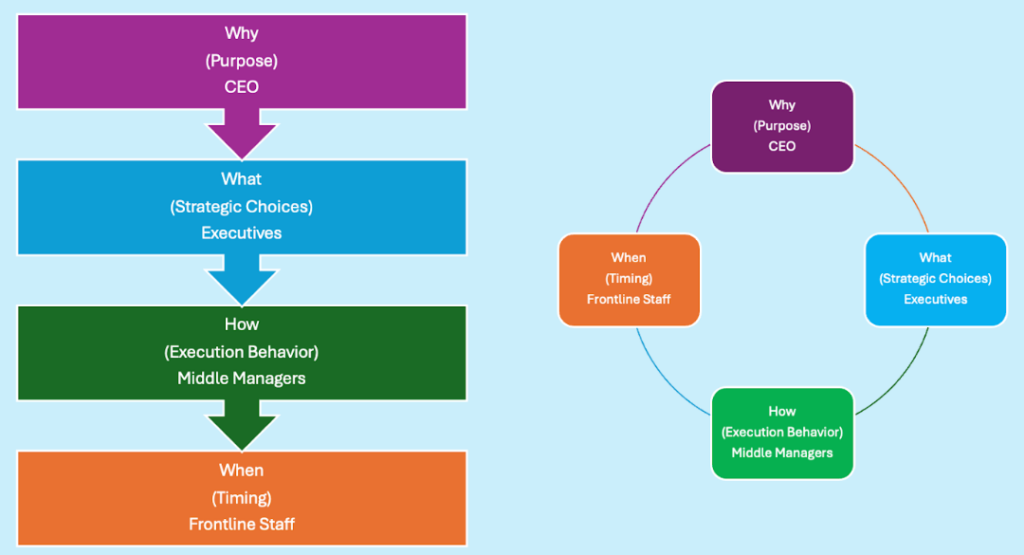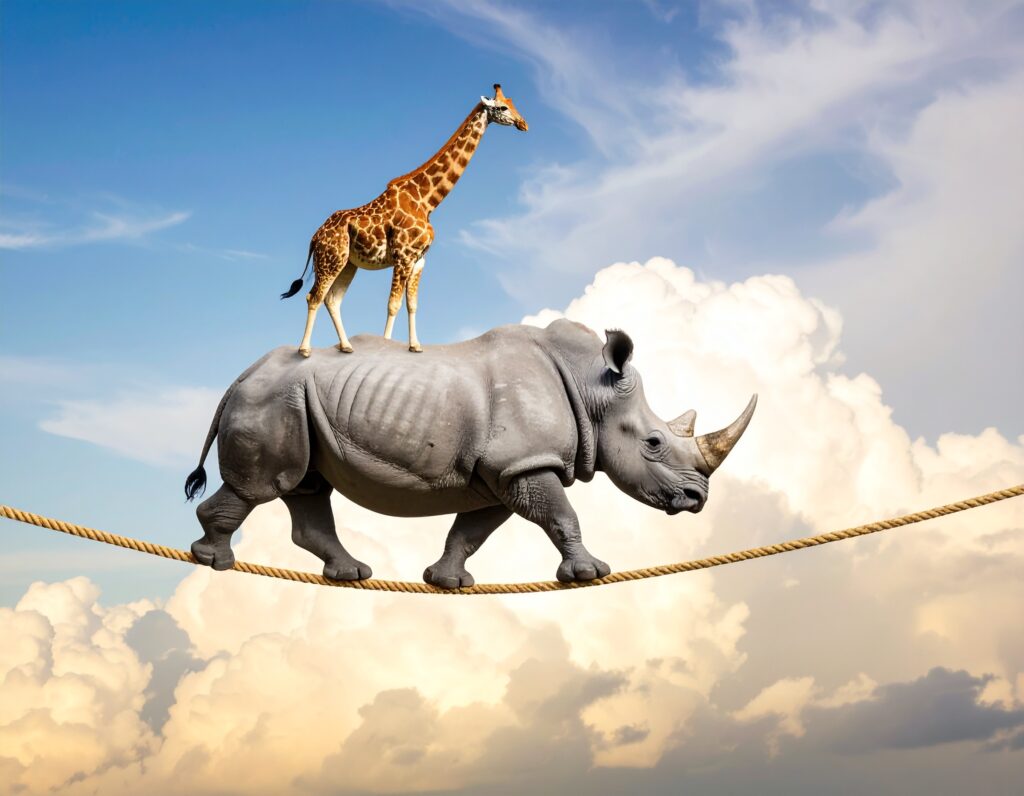What if Culture and Strategy Share a Breakfast?
Today’s Tuesday Reading is from Vijay Menta, Vice President and Chief Information Officer of Worcester Polytechnic Institute. Vijay may be reached at [email protected] or via LinkedIn.
The famous quote, “Culture eats strategy for breakfast,” often attributed to Peter Drucker, reminds us that even the best plans crumble without cultural alignment. But what if culture and strategy sat together at the breakfast table? Not as rivals, but as partners.
Strategy is what you say you’ll do. Culture is what you really do. When they don’t align, trust erodes, aspirations falter, and chaos follows. Today’s most resilient organizations recognize that strategy and culture are intertwined: they feed and strengthen each other.
Traditional View: Culture vs. Strategy
Historically, strategy was the domain of executives, seen as rational and controllable, while culture was considered soft and slow-moving. This separation often led to brilliant plans that failed due to entrenched behaviors and unspoken norms.
Disconnected, organizations struggle with balancing the critical elements such as the “Why,” “What,” “When,” and “How.” These elements, when misaligned, cause strategies to fail.
A New Paradigm: Culture and Strategy as Partners
Imagine culture and strategy sitting side-by-side. Strategy brings the menu, choices, priorities, and goals. Culture sets the atmosphere, the values, and the behaviors. It provides service with a shared mindset that defines success.
When integrated:
- Strategy respects cultural realities.
- Culture evolves to support strategic goals.
- Trust grows across the organization.
Breakfast becomes a metaphor: a shared, intentional beginning that fuels unity, momentum, and success.
The Four Core Elements of Culture and Strategy
Organizations must move from linear to circular, iterative collaboration between culture and strategy, like an ecosystem rather than an assembly line. The core elements:
The Why
The purpose and mission beyond profit. It is owned by executive leaders to define and culture champions to reinforce. It inspires strategy and culture; adapts over time.
The What
The strategic choices and goals. It is owned by executives and project teams. It must align with culture to succeed.
The How
The everyday actions and behaviors. It is owned by everyone and led by middle managers. Its execution reveals gaps and refines strategy.
The When
The timing for pivots and growth. It is owned by strategy teams and middle managers. It is readiness and timing that shape success.
Shifting Models: From Linear, Top Down to Circular, Iterative

As depicted in the diagram above, this flow is circular, not top-down:
- The Why shapes the What.
- The What must match the How.
- The How influences the When.
- The When loops back to validate the Why.
10 Ideas to Bring Culture and Strategy Together
1. Diagnose Honestly
Before setting a strategy, leaders must deeply understand the true current state of the culture, not the version in marketing materials, but the lived, day-to-day experience by conducting anonymous surveys, listening tours, and focus groups. Create safe spaces for brutal honesty, and with a regular cadence that is well understood.
2. Define Cultural Essentials
One must identify and protect the “secret sauce” while evolving where needed by pinpointing the elements that must evolve to enable future strategy. Collaboratively define your non-negotiables and your growth opportunities.
3. Craft Strategy with Culture in Mind
Engage cross-functional teams early and often. Don’t design strategy in a vacuum. Engage employees at multiple levels and ask, “What cultural shifts must happen for this to succeed?” You will be amazed at what you learn when you ask that question!
4. Activate Leaders as Culture Carriers
Leaders must model desired behaviors. Strategies succeed or fail through leadership behaviors and not PowerPoint decks. Build leadership development programs that focus on cultural literacy, storytelling, and behavior modeling.
5. Celebrate Quick and Daily Wins
Stories build momentum faster than stats. Highlight early and daily small victories where culture and strategy are aligned. Stories change hearts faster than stats. Create recognition rituals that reinforce both the “what” (strategic outcome) and the “how” (cultural behaviors demonstrated).
6. Evolve, Don’t Freeze
Regularly revisit assumptions; adapt dynamically. Culture and strategy must both breathe and adapt over time. Institute regular check-ins with quarterly culture and strategy reviews, where beliefs are challenged, not defended. Provide a psychologically safe space for everyone to express themselves without any repercussions.
7. Earn Trust and Respect
Consistency, transparency, and integrity matter most. The invisible foundation of any successful integration is trust. Without trust, even the best strategy collapses. Leaders must consistently act with transparency, reliability, and integrity. Trust is earned over time, not declared. Say what you will do, and do what you say.
8. Build Micro-Communities
Change grows from small groups outward. Culture and strategy are sustained through local ecosystems, not just enterprise-wide initiatives. Create small, voluntary groups and champions that pilot new ways of working aligned with strategy and cultural goals. Real change scales from pockets of excellence outward, not top-down.
9. Connect Individual Purpose to Organizational Purpose
Purpose fuels resilience. When the purpose is well understood, all failures become a learning exercise, and the team continues to build resilience. When people see how their values connect to the organization’s why, engagement and resilience skyrocket. Include purpose-mapping exercises in onboarding, team meetings, and leadership sessions. Repeat and rinse ever so often, and particularly when you onboard new employees
10. Institutionalize Reflection and Learning
Make learning a regular, strategic practice. Make learning an institutional muscle. Organizations that pause to reflect learn faster than those who only “do.” One must invest in the professional development of their employees and encourage continuous learning. Build rituals for collective reflection (e.g., “culture and strategy retrospectives” after key projects). Identify gaps and initiate continuous improvement projects right after the implementation projects.
Real-World Examples
Microsoft’s Cultural Renaissance
- When Satya Nadella became CEO of Microsoft in 2014, he inherited a company famous for internal competition and siloed thinking. Strategic plans existed, but the culture was holding them back.
- Nadella didn’t just issue a new strategy. He launched a cultural transformation centered on a “growth mindset”, encouraging curiosity, collaboration, and learning. Strategy and culture were advanced hand-in-hand. Microsoft regained its innovative edge, restored its reputation, and became one of the world’s most valuable companies.
Netflix’s Culture of Freedom and Responsibility
- Netflix famously codified its culture in a slide deck that went viral, emphasizing autonomy, accountability, and performance. Their strategy, to move aggressively from DVD rental to streaming and later into content creation, was bold and disruptive.
- Without a culture that empowered risk-taking, adaptability, and brutal honesty, Netflix could never have pivoted so successfully. Culture and strategy were two sides of the same coin.
Patagonia’s Mission-Driven Growth
- Patagonia’s strategy to build high-quality, sustainable outdoor gear aligns perfectly with its activist culture. Employees are deeply committed to environmental causes, and the company backs that up with real actions, from suing the government over public land policies to donating Black Friday sales to nonprofits.
- Their culture energizes their strategic decisions; their strategy reinforces their culture. The result? Loyal customers, engaged employees, and consistent growth.
Conclusion: A Partnership for the Future
Culture and strategy are not competitors, they’re essential partners. Organizations that intentionally invite both to the table unlock adaptability, resilience, and human-centered success. The future belongs to companies where culture and strategy are inseparable and breakfast is just the beginning.
The most admired companies of the future won’t just have a brilliant strategy or a great culture. They’ll have both, intertwined, inseparable, and deeply human. So, sharing breakfast in any organization is good for building a sustainable future.
Will you be inviting Strategy and Culture to share a breakfast starting tomorrow?
Last week, we asked where you are currently feeling the greatest need for support or focus as a leader navigating uncertainty.
- 27% said balancing short-term demands with long-term strategy
- 23% said supporting the emotional well-being and morale of my staff
- 19% said managing my own energy, priorities, and resilience
- 17% said communicating clearly and transparently with my team
- 14% said aligning my team’s work with shifting institutional goals

The spread of responses across these five dimensions of needing support or focus underscores an important lesson: As we all navigate uncertainty together, we each bring strengths. Where each of us has areas we need to work on, collectively, those are also areas others of us have relative strengths. Rely on each other. As the proverb goes, if you want to go fast, go alone. If you want to go far, go together.
- September 2025 (3)
- August 2025 (7)
- July 2025 (5)
- June 2025 (4)
- May 2025 (5)
- April 2025 (5)
- March 2025 (4)
- February 2025 (4)
- January 2025 (4)
- December 2024 (3)
- November 2024 (4)
- October 2024 (5)
- September 2024 (4)
- August 2024 (4)
- July 2024 (5)
- June 2024 (4)
- May 2024 (4)
- April 2024 (5)
- March 2024 (4)
- February 2024 (4)
- January 2024 (5)
- December 2023 (3)
- November 2023 (4)
- October 2023 (5)
- September 2023 (4)
- August 2023 (4)
- July 2023 (4)
- June 2023 (4)
- May 2023 (5)
- April 2023 (4)
- March 2023 (1)
- February 2023 (1)
- January 2023 (4)
- December 2022 (3)
- November 2022 (5)
- October 2022 (4)
- September 2022 (4)
- August 2022 (5)
- July 2022 (4)
- June 2022 (4)
- May 2022 (5)
- April 2022 (4)
- March 2022 (5)
- February 2022 (3)
- January 2022 (4)
- December 2021 (3)
- November 2021 (4)
- October 2021 (3)
- September 2021 (4)
- August 2021 (4)
- July 2021 (4)
- June 2021 (5)
- May 2021 (4)
- April 2021 (4)
- March 2021 (5)
- February 2021 (4)
- January 2021 (4)
- December 2020 (4)
- November 2020 (4)
- October 2020 (6)
- September 2020 (5)
- August 2020 (4)
- July 2020 (7)
- June 2020 (7)
- May 2020 (5)
- April 2020 (4)
- March 2020 (5)
- February 2020 (4)
- January 2020 (4)
- December 2019 (2)
- November 2019 (4)
- October 2019 (4)
- September 2019 (3)
- August 2019 (3)
- July 2019 (2)
- June 2019 (4)
- May 2019 (3)
- April 2019 (5)
- March 2019 (4)
- February 2019 (3)
- January 2019 (5)
- December 2018 (2)
- November 2018 (4)
- October 2018 (5)
- September 2018 (3)
- August 2018 (3)
- July 2018 (4)
- June 2018 (4)
- May 2018 (5)
- April 2018 (4)
- March 2018 (5)
- February 2018 (5)
- January 2018 (3)
- December 2017 (3)
- November 2017 (4)
- October 2017 (5)
- September 2017 (3)
- August 2017 (5)
- July 2017 (3)
- June 2017 (8)
- May 2017 (5)
- April 2017 (4)
- March 2017 (4)
- February 2017 (4)
- January 2017 (4)
- December 2016 (2)
- November 2016 (7)
- October 2016 (5)
- September 2016 (8)
- August 2016 (5)
- July 2016 (4)
- June 2016 (12)
- May 2016 (5)
- April 2016 (4)
- March 2016 (7)
- February 2016 (4)
- January 2016 (10)
- December 2015 (4)
- November 2015 (6)
- October 2015 (4)
- September 2015 (7)
- August 2015 (5)
- July 2015 (6)
- June 2015 (12)
- May 2015 (4)
- April 2015 (6)
- March 2015 (10)
- February 2015 (4)
- January 2015 (4)
- December 2014 (3)
- November 2014 (5)
- October 2014 (4)
- September 2014 (6)
- August 2014 (4)
- July 2014 (4)
- June 2014 (4)
- May 2014 (5)
- April 2014 (5)
- March 2014 (5)
- February 2014 (4)
- January 2014 (5)
- December 2013 (5)
- November 2013 (5)
- October 2013 (10)
- September 2013 (4)
- August 2013 (5)
- July 2013 (8)
- June 2013 (6)
- May 2013 (4)
- April 2013 (5)
- March 2013 (4)
- February 2013 (4)
- January 2013 (5)
- December 2012 (3)
- November 2012 (4)
- October 2012 (5)
- September 2012 (4)
- August 2012 (4)
- July 2012 (5)
- June 2012 (4)
- May 2012 (5)
- April 2012 (4)
- March 2012 (4)
- February 2012 (4)
- January 2012 (4)
- December 2011 (3)
- November 2011 (5)
- October 2011 (4)
- September 2011 (4)
- August 2011 (4)
- July 2011 (4)
- June 2011 (5)
- May 2011 (5)
- April 2011 (3)
- March 2011 (4)
- February 2011 (4)
- January 2011 (4)
- December 2010 (3)
- November 2010 (4)
- October 2010 (4)
- September 2010 (3)
- August 2010 (5)
- July 2010 (4)
- June 2010 (5)
- May 2010 (4)
- April 2010 (3)
- March 2010 (2)
- February 2010 (4)
- January 2010 (4)
- December 2009 (4)
- November 2009 (4)
- October 2009 (4)
- September 2009 (4)
- August 2009 (3)
- July 2009 (3)
- June 2009 (3)
- May 2009 (4)
- April 2009 (4)
- March 2009 (2)
- February 2009 (3)
- January 2009 (3)
- December 2008 (3)
- November 2008 (3)
- October 2008 (3)
- August 2008 (3)
- July 2008 (4)
- May 2008 (2)
- April 2008 (2)
- March 2008 (2)
- February 2008 (1)
- January 2008 (1)
- December 2007 (3)
- November 2007 (3)
- October 2007 (3)
- September 2007 (1)
- August 2007 (2)
- July 2007 (4)
- June 2007 (2)
- May 2007 (3)
- April 2007 (1)
- March 2007 (2)
- February 2007 (2)
- January 2007 (3)
- December 2006 (1)
- November 2006 (1)
- October 2006 (1)
- September 2006 (3)
- August 2006 (1)
- June 2006 (2)
- April 2006 (1)
- March 2006 (1)
- February 2006 (1)
- January 2006 (1)
- December 2005 (1)
- November 2005 (2)
- October 2005 (1)
- August 2005 (1)
- July 2005 (1)
- April 2005 (2)
- March 2005 (4)
- February 2005 (2)
- December 2004 (1)
